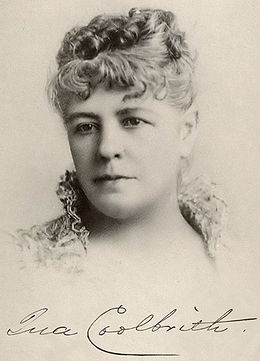
Back إينا كولبرث Arabic اينا كولبريث ARZ Ina Coolbrith German Ina Coolbrith French Ina Coolbrith Hausa Ina Coolbrith Italian ინა კულბრითი Georgian Ina Coolbrith NN Ina Coolbrith Polish Ina Coolbrith Portuguese

Ina Donna Coolbrith (born Josephine Donna Smith; March 10, 1841 – February 29, 1928) was an American poet, writer, librarian, and a prominent figure in the San Francisco Bay Area literary community. Called the "Sweet Singer of California",[1] she was the first California Poet Laureate and the first poet laureate of any American state.[2]
Coolbrith, born the niece of the Church of Jesus Christ of Latter-day Saints founder Joseph Smith, left the Mormon community as a child to enter her teens in Los Angeles, California, where she began to publish poetry. She terminated a youthful failed marriage to make her home in San Francisco, and met writers Bret Harte and Charles Warren Stoddard with whom she formed the "Golden Gate Trinity" closely associated with the literary journal Overland Monthly. Her poetry received positive notice from critics and established poets such as Mark Twain, Ambrose Bierce and Alfred Lord Tennyson. She held literary salons at her home in Russian Hill[3]—in this way she introduced new writers to publishers. Coolbrith befriended the poet Joaquin Miller and helped him gain global fame.
While Miller toured Europe and lived out their mutual dream of visiting Lord Byron's tomb, Coolbrith cared for his Wintu daughter and members of her own family. As a result, she came to reside in Oakland and accepted the position of city librarian. Her poetry suffered as a result of her long work hours, but she mentored a generation of young readers including Jack London and Isadora Duncan. After she served for 19 years, Oakland's library patrons called for reorganization, and Coolbrith was fired. She moved back to San Francisco and was invited by members of the Bohemian Club to be their librarian.[4]
Coolbrith began to write a history of California literature, including much autobiographical material, but the fire following the 1906 San Francisco earthquake consumed her work. Author Gertrude Atherton and Coolbrith's Bohemian Club friends helped set her up again in a new house, and she resumed writing and holding literary salons. She traveled by train to New York City several times and, with fewer worldly cares, greatly increased her poetry output.
On June 30, 1915, Coolbrith was named California's poet laureate, and she continued to write poetry for eight more years. Her style was more than the usual melancholic or uplifting themes expected of women—she included a wide variety of subjects in her poems, which were noted as being "singularly sympathetic" and "palpably spontaneous".[5] Her sensuous descriptions of natural scenes advanced the art of Victorian poetry to incorporate greater accuracy without trite sentiment, foreshadowing the Imagist school and the work of Robert Frost.[6] California poet laureate Carol Muske-Dukes wrote of Coolbrith's poems that, though they "were steeped in a high tea lavender style", influenced by a British stateliness, "California remained her inspiration."[7]
- ^ Wheeler, Edward Jewitt; Crane, Frank (April 1900). "American Poets of To-Day: Ina Coolbrith". Current Opinion. 28 (1): 16–17.
- ^ Western Literature Association (1987). J. Golden Taylor (ed.). A Literary history of the American West. TCU Press. p. 181. ISBN 978-0-87565-021-0.
- ^ Tarnoff, Benjamin (2014). The Bohemians: Mark Twain and the San Francisco Writers Who Reinvented American Literature. Penguin Books. ISBN 9781594204739.
- ^ "Ina Donna Coolbrith | American poet". Encyclopædia Britannica. Retrieved August 21, 2017.
- ^ Cite error: The named reference
Moulton1889was invoked but never defined (see the help page). - ^ Axelrod, 2003, p. 610
- ^ Muske-Dukes, Carol (December 12, 2008). "Single laurel, common voice". Los Angeles Times. Retrieved March 20, 2010.